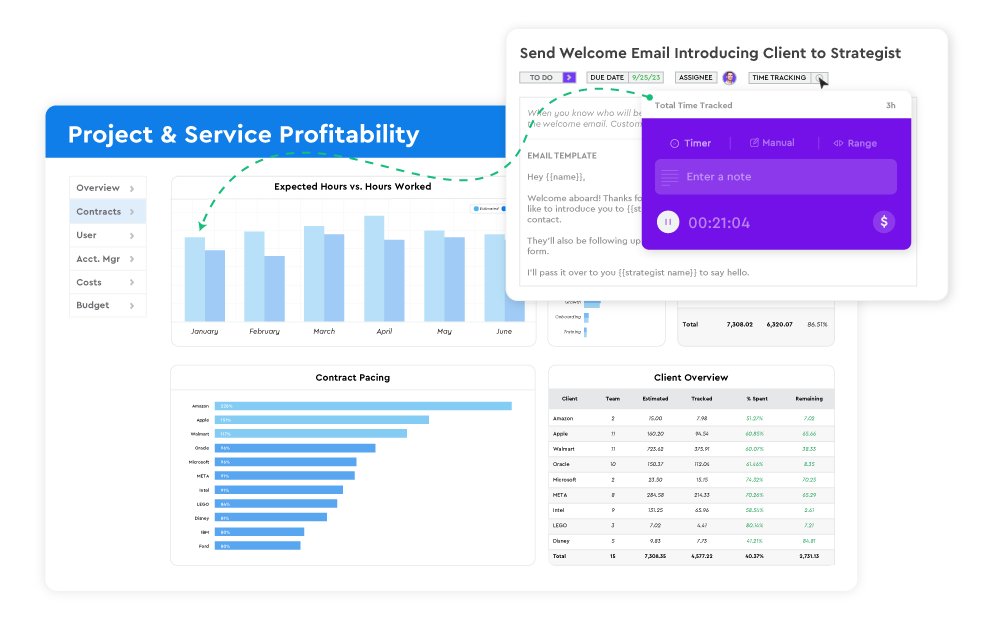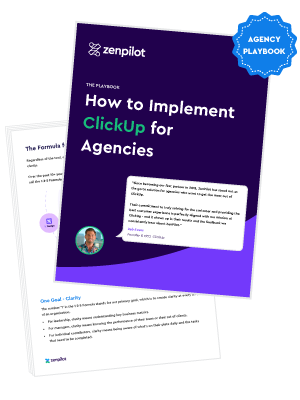1) Optimize Your Pricing Strategy
Charging more to increase profit may sound overly simple but you’d be surprised how many agency owners have a blind spot when it comes to pricing. If your pricing is based purely on the amount of time it takes to fulfill a client’s need, you’re lowballing yourself.
Value or Performance-Based Pricing?
What you really need to consider is how much value your service is generating for the client, then price accordingly. When using value-based pricing, it’s essential that you track milestones, compile detailed analytics, and keep your client in the loop on the latest breakthroughs.
After all, you can’t expect clients to continue paying for value if they don’t even grasp the significance of what’s being achieved. To take this pricing strategy to the next level, you can start looking at performance-based pricing.
This will make sense for some agencies more than others but, if you meet the criteria, it could be a great way to increase your client LTV and agency profitability. For example, if your agency focuses on paid advertising then you should be charging based on results rather than hours.
If you’re getting e-commerce clients a ROAS (return on ad spend) of $4 for every $1 spent, they won’t hesitate to pay you a $10,000 monthly performance bonus — as long as you keep hitting results that make them six-figure or even seven-figure profits.
2) Seal Up Your Leaky Buckets
Leaky buckets are the enemy of profitability. The most common leaky buckets for agencies are the sales process and your contracts.
Don’t Promise the Moon If You Can’t Deliver the Moon
The unfortunate truth about some sales teams is that they will literally say anything to win a new client. In this kind of environment, sales may win the account, but the project fulfillment team is who will lose at the end of the day.
Making promises that can’t be fulfilled puts a major strain on the entire agency. Those who deal with the client after the sales process are walking into a slaughterhouse. Although some client relationships built on unrealistic expectations can be saved, they often fall flat at the great expense of the team.
We ran a relationship built on realistic expectations several years ago. I swear, we spent more time trying to put out fires and make them happy than we did servicing every other client. The result? Lost time, lost resources, and an ultimately failed relationship.
As an agency, you can’t afford to have a single relationship like this. The reality, however, is that most agencies have not only one of these, but several.
It’s important to make it clear in the sales process how your agency works and what you do. If there’s something that is either just plain unreasonable or not within your skill set, it’s best to communicate that and move on to the next prospect.
Solidify Relationships with Air-Tight Contracts
Beyond the way sales sets expectations, contracts are an agency’s leakiest bucket.
The goal of a contract is to set out the boundaries and journey of the relationship in the clearest terms possible. If you slim on any detail, you’re setting your agency up to get taken advantage of.
Here are some quick tips on writing air-tight contracts:
- Break down the service your providing in granular detail. How many revisions are included? What specific deliverables will be delivered?
- Address additional work. What happens if clients want something outside the scope of work? I recommend putting a clause stating that additional work will be quoted separately.
- Refunds. Are deposits refundable? Are final payments refundable? I recommend saying no refunds for either case.
- Signify what constitutes the end. What concludes the contract? Most likely, it’ll be the completion of the deliverables and final payment received.
- Specify payment terms. How is the client going to pay for your services? Is it 50% up front, 50% upon conclusion? Is it on a retainer basis? And also, what happens if invoices are paid late?
- Confidentiality. It’s vital to include a confidentiality clause in your contracts. This clause should protect both parties from themselves. Detail what information is confidential and state that it shouldn’t be released without written permission.
- Breach of contract. What constitutes a breach of contract and what are the consequences?
3) Stop Scope Creep Early and Consistently
Scope creep is the not-so silent killer of an agency’s margins.
Scope creep doesn’t happen overnight. It is the result of your day-to-day decisions. Granting small requests eventually builds into larger and larger requests. One day, you might be greeted with a request far outside the bounds of the agreement. If you’ve allowed the little requests, this build-up isn’t surprising.
From the first request outside the project scope to the last, choose to say “no.”
You Don’t Have to be Rude About It
The way you approach this makes all the difference. You don’t have to be rude and say a blunt “no.” If a client asks for something outside the scope say, “Of course! Let me get you a quote for that.”
See the change there? We’re saying yes, but not saying yes for free.
If a Client Insists and Persists
In some cases, a client might insist that you do something for free. When saying, “Of course! Let me get you a quote for that” doesn’t work—it’s OK to be a little bit firmer.
It’s important to go into detail about the “why” behind what you’re saying. If you’re declining to grant a scope request beyond what you’ve agreed upon, your why is simple. Explain that what they’re asking for isn’t in the contract.
No matter how large or how small, additional work takes time. In most cases, what a client is asking for also takes more time than they anticipate. Since you have your air-tight contract, lean into it and what you both agreed upon in that document.
Most times, if you can explain that element of the why, the client will understand without issues. In extreme cases, a scope creep request will persist. At this point, I try to put things in perspective. We’re running a business here. It’s just not good business to give away anything, especially services.
Again, lean into your initial agreement. That’s why it’s vital to set expectations up front and solidify those into a detailed contract.
4) Don’t Settle for Small, Pesky Clients
“A $4,000 retainer client will take more time and resources than a $10,000 retainer client. Go for the big deals.” -Mike Lieberman, Square 2 Marketing
A lot of agencies sell themselves short. By doing so, they think they have to settle for small, pesky clients. In almost every case, those kinds of clients cause 90-percent of the headaches and only provide 10-percent of the income.
I promise you—you’re good enough. You have what it takes. Shoot for the stars and go after the biggest clients you possibly can.
5) Run Semi-Annual Client Checkups
According to Harvard Business Review, acquiring new clients is anywhere from 5x to 25x more expensive than retaining the clients you already have. In other words, keeping clients for longer could reduce your agency’s acquisition costs and increase profit as a result.
Running client checkups twice a year is one of the best ways to ensure that you’re still generating value for the people who generate your revenue. Ask them to rate their general satisfaction, see which parts of the service they like most, or where you’ve dropped the ball.
In addition to extending your average client retention period, these client checkups can also help you identify opportunities that will bring in fresh revenue from old customers. Maybe they want to expand beyond paid advertising and start generating traffic for their blog.
Or, alternatively, they’re satisfied with their website metrics but want to increase their presence on certain social media platforms. Whatever it may be, finding out early is going to increase your odds of capturing their expanded budget instead of having to share it with another contractor.
6) Automate Time-Consuming Workflows
Agency profitability is often thought of as a challenge that needs to be approached with better marketing, more efficient sales processes, and brute-forcing more revenue in the door. In reality, operations play a huge role in how profitable your business will be.
You’d be surprised how many agencies suffer from a low utilization rate purely due to the fact that their team members are too distracted by busy work. Sending emails, checking on statuses, filling out time sheets, and generating reports — i.e. easily automated, low-value tasks.
In contrast, a team that uses the right project management tool (one that takes the guesswork out of task status and team communication) while simultaneously making use of automated workflows will be able to focus their full attention on generating agency revenue.
Automation does require an upfront time investment during the setup phase but, by eliminating repetitive tasks from your team’s workflow, it will continue to pay dividends for the months (or even years) to come.
7) Hire Slow, Fire Fast
Hiring too fast is a big mistake. Hiring a bad team member will set you back for months and months and months.
Have a Clear Idea Who You’re Looking For
Take your time during the hiring process, and have a clear idea of who you’re looking for. Before even considering adding to your team, clearly outline what that person is doing. Vague items aren’t good enough and can put a sour taste in the mouth of the best team members.
Get a Variety of Perspectives
When you’re hiring, bring in your entire team and a variety of perspectives. You might have one impression, but someone else might have another.
Build a Talent Bench
The most talented people out there most likely already have a job. Start networking and building your bench of dream team members.
When the day comes when you have an opening, go back to your talent bench and see if the potential exists for you to work together.
Get to Know Them Beyond the Professional Setting
Something that Michael Hyatt does with people he’s ready to hire is takes them out to dinner. Why? He wants to see how they interact with their significant other, the wait staff, and the general public in a non-professional setting.
8) Leverage Your Teams Specialties
After you hire an amazing team, taking your agency from a collection of generalists to a team of specialists will have a major impact on profitability. As people learn about a specific service line, they’ll be able to handle its tasks faster and more efficiently.
The influence of learning on speed is even apparent in animals.
In 1898, the American psychologist Edward Thorndike conducted an experiment where he would put cats in a box and then wait for them to escape — often by pulling a lever or pulling on a cord. In the first three tests, the cat’s average escape time was over a minute.
By the last three trials, that average escape time dropped to 6.3 seconds. Suffice it to say that the work of an average agency is more complex than cats pulling levers, but the same laws of learning still apply.
Having one team member for all things organic and another for everything related to paid advertising may seem cost-effective (seeing as you’re minimizing salaries) but only until you realize they’ll take twice as long to complete projects due to the lack of specialization.
Conversely, having one person for each service line (Facebook ads, Google ads, SEO, content marketing, social media management, etc.) will inflate overhead but allow you to generate more value for the client in a shorter amount of time — thus increasing your revenue potential.
The fact is, as the scope of work gets broader, humans become less efficient.
This may seem counterintuitive since conventional wisdom dictates that running a lean, profitable company is easiest when you have fewer people working on more things. However, more people working on fewer things (per person) can often be more efficient.
9) Establish Repeatable, Scalable, Predictable Processes for Everything You Offer
We’re all about establishing repeatable, scalable, predictable processes for everything you do.
It takes time on the front end, but in the long run, it will do so much good for your agency. You will get better, you will get faster, and your clients will love knowing what to expect at every turn.
Implement These Strategies To Start Maximizing Your Agency’s Profitability
As you can see, increasing agency profitability doesn’t mean reducing the quality of your service. In fact, providing a better service run by experts will complement your profit margins rather than taking away from it — at least in the long run.
If you utilize the nine strategies outlined in this article, it’s only a matter of time before your agency becomes more profitable, efficient, and valuable to clients.
In the meantime, take our Agency Project Management Benchmark to see where you may have some operational inefficiencies that can be improved.
Before you get started
Take the Agency Project Management Benchmark Assessment so you know what areas to prioritize.





